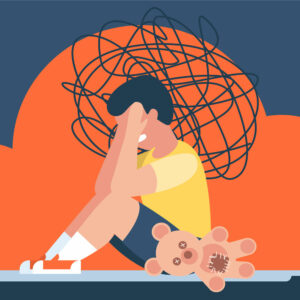How Self-Image Is Tied to Trauma
April 3, 2023
Childhood trauma is one of the biggest contributing factors to mental health and addiction issues later in life. Children have core needs that must be met in order to develop into healthy adults, and if those needs are not met, the trauma that results can have lasting negative effects.
One of the most devastating impacts of early trauma is on the way children view themselves as they begin to form their identity. The effects of trauma on self-image are multifaceted, and negative self-image is tied to a range of psychological and even physiological issues.
The Impact of Trauma on Self-Image in Early Childhood
 Trauma is hard on adults, but as fully developed individuals who can separate themselves from their circumstances and their environment, most adults can at least make some sense of the traumas they experience. Children, however, especially infants, are incapable of differentiating themselves from their environment. This leads young children to intimately connect trauma with their sense of self.
Trauma is hard on adults, but as fully developed individuals who can separate themselves from their circumstances and their environment, most adults can at least make some sense of the traumas they experience. Children, however, especially infants, are incapable of differentiating themselves from their environment. This leads young children to intimately connect trauma with their sense of self.
Meadows Senior Fellow Laurence Heller, PhD, writes in his influential book, Healing Developmental Trauma: How Early Trauma Affects Self-Regulation, Self-Image, and the Capacity for Relationship, that “when children experience early preverbal trauma, they develop a distorted self-image in an attempt to make sense of their ongoing distress. Infants in distress feel bad; when the distress continues, they end up thinking they are bad.”
According to Heller, when something bad happens to a child, they believe it has happened because they are bad and deserving of it, not because the people inflicting the trauma on them are bad. This is the only way young children can make sense of trauma, and at first it serves them well.
Unfortunately, what starts as a protective coping mechanism outlives its usefulness and lingers into adulthood, causing nervous system dysregulation, dissociation, and self-esteem issues.
“The coping strategies that initially helped us survive as children over the years become rigid beliefs about who we are and what the world is like,” writes Heller. “Our beliefs about ourselves and the world, together with the physiological patterns associated with these beliefs, crystallize into a familiar sense of who we are. This is what we come to view as our identity.”
Trauma Related to Poor Self Body-Image
This distorted self-image often affects body-image, too. Anger is a natural response to an inadequately supportive or actively threatening environment, but for young children, anger toward their caregivers can threaten much-needed attachment. Since the anger must go somewhere, it often gets turned inward.
The anger that traumatized children feel manifests itself as self-hatred, the belief that there is something inherently wrong in them that makes them deserve the abuse or neglect they experience.
“They hate themselves for their perceived physical flaws and their psychological symptoms,” writes Dr. Heller. “They often feel that their body is their enemy. They hate their body for the fear and distress they experience and may focus their hatred on some real or imagined physical inadequacy.”
The Link Between Self-Image and Mental Health
Unfortunately, nervous system dysregulation, disruptions in attachment, and distortions of identity become roadblocks that keep us from experiencing the connection that we as humans deeply need. And, as Heller writes, “An impaired capacity for connection to self and others, and the ensuing diminished aliveness, are the hidden dimensions that underlie most psychological and many physiological problems.”
Low self-esteem, chronic anxiety, and depression are often rooted in the physiological dysregulation that comes from early trauma.
Low self-esteem, chronic anxiety, and depression are often rooted in the physiological dysregulation that comes from early trauma. When a child internalizes trauma and believes they have caused it, they deem themselves unworthy of love, which hinders their ability to connect with others. They may also see others as dangerous or threatening due to betrayal by their early attachment figures. These relational blocks play a foundational role in the development of mental illness and other maladaptive coping mechanisms like substance abuse.
Healing for the Effects of Trauma on Self-Image
Over his 45-year career, Dr. Heller has developed a therapeutic model, the NeuroAffective Relational Model (NARM), to address the effects of relational, developmental, and attachment trauma, often collectively called complex trauma.
NARM uses five primary organizing principles to address trauma:
- Supporting connection and organization
- Exploring identity
- Supporting emotional completion
- Working in present time
- Supporting reregulation of all systems of the body
Despite ongoing disconnection from self and others caused by early trauma, all of us naturally long for and lean toward connection. The NARM model works to help us become more connected to our authentic self, which allows us to connect more authentically with others.
Regarding self-image, the NARM model helps dismantle the shame and self-hatred people who have early childhood trauma live with. “Simply understanding that their shame reflects the environmental failure they experienced rather than who they are,” writes Heller, “has helped many people who suffer from lifelong patterns of low self-esteem, shame, and a sense of worthlessness to see themselves in a new, more compassionate way.”
Here at Rio Retreat Center, we use NARM along with other trauma-informed therapeutic models in our workshops to bring you healing and empowerment in various stages of your journey. Our Survivors and Mending Heartwounds workshops are particularly helpful for anyone struggling with the effects of trauma, poor self-image, and related issues.
Contact us today to find out how we can help you discover your authentic self and begin to live a life of connection and freedom.
